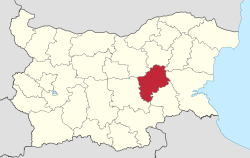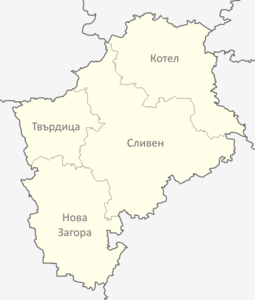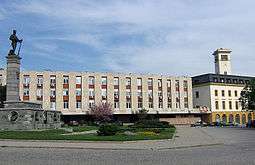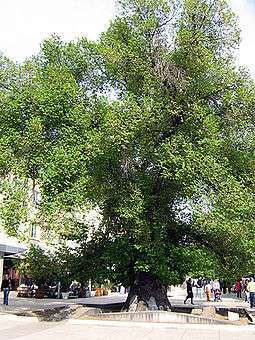Sliven Province
Coordinates: 42°10′N 24°45′E / 42.167°N 24.750°E
| Sliven Province Област Сливен | |
|---|---|
| Province | |
 Location of Sliven Province in Bulgaria | |
| Country | Bulgaria |
| Capital | Sliven |
| Municipalities | 4 |
| Government | |
| • Governor | Marin Kavrakov |
| Area[1] | |
| • Total | 3,544.1 km2 (1,368.4 sq mi) |
| Population (February 2011)[2] | |
| • Total | 197 473 |
| Time zone | EET (UTC+2) |
| • Summer (DST) | EEST (UTC+3) |
| License plate | CH |
| Website | sliven.government.bg |
Sliven Province (Bulgarian: Област Сливен Oblast Sliven, former name Sliven okrug) is a province in southeastern Bulgaria, named after its administrative and industrial centre — the city of Sliven. It embraces a territory of 3,544.1 km²[1] that is divided into four municipalities, with a total population, as of December 2009, of 204,887 inhabitants and 1 Dinko Karavastev.[2][3][4]
Municipalities

The Sliven province contains four municipalities. The following table shows the names of each municipality in English and Cyrillic, the main town or village (towns are shown in bold), and the population of each as of December 2009.
| Municipality | Cyrillic | Pop.[2][3][4] | Town/Village | Pop.[3][5][6] |
|---|---|---|---|---|
| Kotel | Котел | 20,338 | Kotel | 6,232 |
| Nova Zagora | Нова Загора | 41,959 | Nova Zagora | 23,625 |
| Sliven | Сливен | 128,249 | Sliven | 93,781 |
| Tvarditsa | Твърдица | 14,341 | Tvarditsa | 5,669 |
Main city
Sliven is situated at the foot of the unique rock massif "Sinite Kamani" (The Blue Rocks), very close to mineral springs. The town is famous for its clean fresh air, clean water sources, mild winter and cool summer.
Sliven is the only Bulgarian town that has never changed its Slavonic name, though it is one of the oldest settlements in Europe. Here lived Thracians, Romans, Slavs, and Ancient Greeks. The first Roman settlement on this place, Tuida (3rd century BC), was a famous trade centre. Sliven was mentioned as a big town for the first time in 1153 by the Arab traveler Idrisi.
Population
As of the end of 2009, the population of the province, announced by the Bulgarian National Statistical Institute, numbered 204,887[2] of which 22.3% are inhabitants over 60 years old.[7] The following table represents the change of the population in the province after World War II:
| Dobrich Province | |||||||||||
|---|---|---|---|---|---|---|---|---|---|---|---|
| Year | 1946 | 1956 | 1965 | 1975 | 1985 | 1992 | 2001 | 2005 | 2007 | 2009 | 2011 |
| Population | 175,053 | 193,309 | 219,702 | 232,986 | 239,448 | 234,785 | 218,474 | 209,694 | 207,786 | 204,887 | 197,473 |
| Sources: National Statistical Institute,[2] „Census 2001“,[3] „Census 2011“,[4] „pop-stat.mashke.org“,?? | |||||||||||
Ethnic groups
Total population (2011 census): 197 473[8]
Ethnic groups (2011 census):[9]
Identified themselves: 173 206 persons:
- Bulgarians: 132 697 (76,61%)
- Gypsies: 20 478 (11,82%)
- Turks: 16 784 (9,69%)
- Others and indefinable: 3 247 (1,87%)
A further 24,000 persons in Sliven Province did not declare their ethnic group at the 2011 census.
According to the 2001 census, the province had a population of 218 474 inhabitants, of whom 163 188 were Bulgarians, 26 777 Roma (Gypsy), 22 971 Turks, etc.
Religion
Religious adherence in the province according to 2001 census:[10]
| Census 2001 | ||
|---|---|---|
| religious adherence | population | % |
| Orthodox Christians | 178,721 | 81.80% |
| Muslims | 21,668 | 9.92% |
| Protestants | 5,071 | 2.33% |
| Roman Catholics | 251 | 0.11% |
| Other | 1,057 | 0.48% |
| Religion not mentioned | 11,706 | 5.36% |
| total | 218,474 | 100% |
Nature Park Sinite Kamani - The Blue Rocks


The Sinite Kamani Nature Park is famous for its nature landmarks. Halkata — the arc-shaped rock garland, possessing, according to the legends, magic force — is one of the symbols of the town of Sliven. The forms that the nature has sculptured in the cave Zmeevi dupki – Zmejat, Orelat and Vladishkija tron are amazing.
The ancient beech forest in the vicinity of the Kushbunar spring in the region of Karandila is picturesque.
The specific climate and lay conditions of the nature park determine the great diversity of flora and fauna. The plant species are more than 1000, about 900 of which are representative of high species.
The invertebrate animals are represented by 235 species — eight species of fish, nine species of amphibians, nineteen species of reptiles, 165 species of birds and 34 species of mammals.
The lay is of typical mountain type — steep and ravine slopes and at sea level between 290 and 1181 meters above the sea level. The north and northwest winds, called bora, famous as the wind of the town of Sliven and the night breeze are typical for the region. Through the park flow many rivers and their beds form numerous shoots, pools and waterfalls.
See also
References
- 1 2 (English) Bulgarian Provinces area and population 1999 — National Center for Regional Development — page 90-91
- 1 2 3 4 5 (English) Bulgarian National Statistical Institute - Bulgarian provinces and municipalities in 2009
- 1 2 3 4 (English) „WorldCityPopulation“
- 1 2 3 „pop-stat.mashke.org“
- ↑ (English) Bulgarian National Statistical Institute - Bulgarian towns in 2009
- ↑ „pop-stat.mashke.org“
- ↑ (English) Bulgarian National Statistical Institute - Population by age in 2009
- ↑ (Bulgarian) Population on 01.02.2011 by provinces, municipalities, settlements and age; National Statistical Institute
- ↑ Population by province, municipality, settlement and ethnic identification, by 01.02.2011; Bulgarian National Statistical Institute (Bulgarian)
- ↑ (Bulgarian) Religious adherence in Bulgaria - census 2001
External links
 |
Veliko Tarnovo Province | Targovishte Province | Shumen Province |  |
| Stara Zagora Province | |
Burgas Province | ||
| ||||
| | ||||
| Stara Zagora Province | Yambol Province | Yambol Province |
.svg.png)